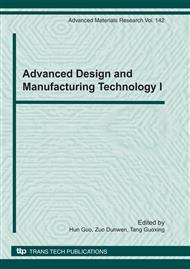p.233
p.238
p.243
p.248
p.253
p.258
p.262
p.266
p.270
Research on the Machinability of Hydrogenated Cylindrical Shell Materials (2.25 Cr-1Mo-0.25V Steel)
Abstract:
Firstly, with studying three typical aspects as cutting force, cutting temperature and chip breaking behavior, contrast experiments of machinability were made on hydrogenated cylindrical shell materials (2.25Cr-1Mo-0.25V), 45 steel, and stainless steel (1Cr18Ni9Ti). The experiment results show that the depth of cut ap have a larger effect on the main cutting force FZ and the cutting temperature θ than the affection of the feedrate f, for that reason, in order to reduce the main cutting force FZ and the cutting temperature θ, large feedrate situation will be better for machining work of hydrogenated cylindrical shell materials. When cutting hydrogenated cylindrical shell materials , many difficult points appearance, such as large cutting force, high cutting temperature, serious chips winding, chips difficult to break etc, which has worse machinability even than stainless steel(1Cr18Ni9Ti).
Info:
Periodical:
Pages:
253-257
Citation:
Online since:
October 2010
Authors:
Price:
Сopyright:
© 2011 Trans Tech Publications Ltd. All Rights Reserved
Share:
Citation:


